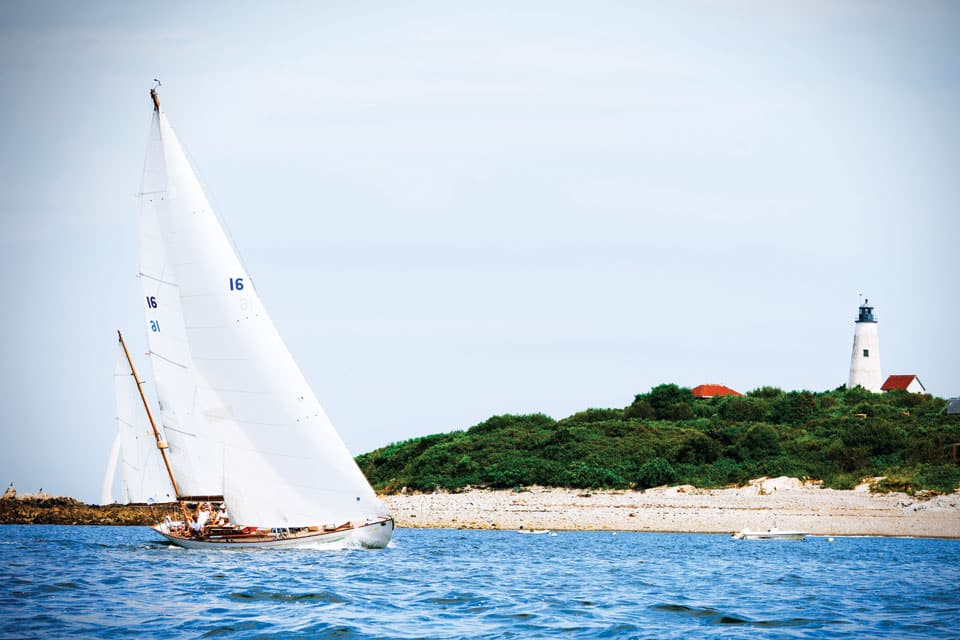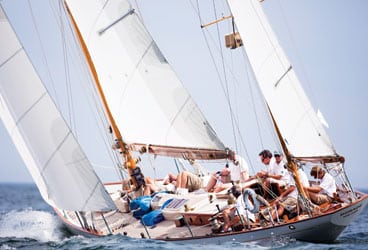
Dorade
Any sailor worth his boots would be giddy to stroll down the waterfront of historic Marblehead, Massachusetts, while chasing down a promised berth on Dorade, the most famous wooden racing yacht of the 20th century. She’s the slender beauty that in the early 1930s launched Olin and Rod Stephens to half a century at the pinnacle of American yachting: Olin’s first offshore design, done at the tender age of 22; the springboard for the design and brokerage firm Sparkman & Stephens; and a smashing competitive success for two young brothers whose triumphs in her forever altered the American yachting landscape.
Ridiculed by the old guard as too slim and lightly built to go to sea, Dorade stomped all comers through the Great Depression and beyond, winning from one coast of the United States to the other and from England to Hawai’i. She won the Transatlantic Race of 1931, the Transpac, the Bermuda Race, and the Fastnet, and she remains a seagoing icon—”On one hand, lovely and dainty, and on the other, purposeful and determined” writes Douglas D. Adkins in his excellent new book, Dorade: the History of an Ocean Racing Yacht. “There is no other racing yacht with her enduring fame and public presence.”
I was lucky to score a two-day gig crewing on Dorade at the Panerai Classic Yachts Challenge in August 2012, but no one bothered to say exactly where she’d be. I’d never laid eyes on her, and I’d only been to Marblehead a time or two. But at 52 feet of gleaming wooden perfection, she shouldn’t be hard to find. I parked the truck, shouldered my seabag, and headed for the most prominent place in town, the public landing, and there she lay, pretty as kiss my hand, in fine company.
__
Dorade bobbed lightly at the fuel dock between a sleek, black, 50-foot Q boat called Nor’easter and an immaculately restored Herreshoff gaffer called Nellie. Nearby, the towering, fully restored, turn-of-the-century New York Yacht Club 50 Spartan and Donald Tofias’ 76-foot Herreshoff replica Wild Horses tugged at their tethers, all polished to a shine. In this crowd, Dorade didn’t even stand out. She simply held her own in a dignified way.
Her newest owner, real-estate developer Matt Brooks of San Francisco, spent a small fortune refurbishing the 82-year-old yawl after buying her from Edgar Cato in 2010, and it shows. Brooks was supposed to be aboard for the Panerai but couldn’t make it because of family issues. A pity, as he’d assembled a crackerjack crew to sail against 67 other yachts of various sizes and vintages, from creaky old gaffers to sparkling replicas.
Brooks brought in Brad Read, the executive director of Sail Newport, a nonprofit located in Newport, Rhode Island, and a great small-boat racer, to steer, and a cast of grizzled veterans, mostly from around Marblehead, to pull the strings. Bob Hood, son of Ted, trimmed headsails, for example, and around-the-world adventurer Cam Lewis’ young son Max was the Nipper, assigned to tend the mizzen. Max greeted me with a frosty Heineken to chase away the road grime and a crew uniform to parade around town in. Good one, Max!

| |Designed in 1929 and launched the following year, Dorade today still maintains an active racing schedule, thanks to a loving owner and a thorough refit.|
The regatta format was two days of pursuit racing. Over the course of about an hour, the Race Committee would send smaller boats off first and bigger ones last, with the hopes that this would avoid any pileups at the starting line and that they’d all fetch up at the harbor finish in a colorful mass after 17 miles of sun-kissed sailing. It’s all about the spectacle at regattas like this, and it worked as planned, though the really good convergences were out on the course at government turning marks, where beauties overtook beauties overtaking beauties. By good fortune, southwest sea breezes held up all weekend under a classic New England sky, that unpredictable panoply of towering cumulus, rolling gray weather fronts, and brilliant bursts of sun.
For sure it was thrilling to be aboard one of the handsomest boats in America, yet it was hard to keep your mind on the teak and varnished oak, pine, and mahogany beneath your feet or the straining canvas aloft as a steady array of stars and starlets crossed your bow or fell astern. They say even the old dog quivers when he sees the quail; if you love boats and the sea and your heart still works, it will surely flutter at the sound of a bow wave chuckling under the meat-cleaver bow of an old wooden 6-Meter, 8-Meter, or 12-Meter, a dart-thin S Boat, or a one-off gaffer, close aboard. And so it did.
As we made our way to the starting line that first day, the master of Dorade‘s latest refit walked us through some simple maneuvers. Greg Stewart, a partner at Nelson-Marek Yacht Design in San Diego, was hired by Brooks to update and upgrade Dorade over the 2011 offseason.
A 6-Meter owner himself, Stewart sails on Dorade whenever he can and will fly across the country to do so. He oversaw a ton of work to bring her back, including 21 new bronze winches; a new Yanmar diesel tucked away in an old bin that used to store coal; a new rudder; new offset folding Gori prop and shaft; epoxy-and-spruce main and mizzen masts and booms; a new oak stem; a massive, custom bronze stem fitting; state-of-the-art electronics below (all hidden in the original mahogany woodwork); the list goes on.
| The Podium Dorade not only turns heads; she also brings home the hardware. A partial listing of trophies, taken from the dorade.org website, includes: 1930: Bermuda Race, Class B, second, first all-amateur crew 1931: Transatlantic Race, first 1932: Bermuda Race, first 1933: Fastnet Race, first 1936: Transpacific Race, first 1947-1979: 15 Swiftsure races, first in class AA 1947-1948, 1951, 1954, 1964 2011: Opera House Cup, Robert H. Tiedemann Memorial Award, most Authentic Yacht 2012: Les Voiles de St. Barth, Classic Class, first 2013: Newport Beach to Cabo San Lucas Race, PHRF class, first |
Since many of the crew were new to the boat, Stewart wanted to show us how to do such basic things as setting the spinnaker pole, changing headsails, and the like. Crew boss Nate Burke had sent me up forward to work the mast, along with a strapping local named Jim Golden, and we were duly attentive. “I’m going to show you how to take the spinnaker pole forward,” said Stewart, a bespectacled engineer, who assigned me to one end of the pole and Golden to the other, then had someone else clip on and tend the topping lift so that when we brought the gleaming wooden stick forward, it would be fully supported, just in case some oaf stumbled or tripped.
The point was clear—when you’re taking grandma’s burled walnut hutch upstairs to its new spot in the master bedroom, you don’t just grab it and go. Stewart knew he couldn’t demonstrate how to do everything; he just wanted to make clear that this wasn’t somebody’s battered J/24, and every move required thought and care.
His point was reinforced as we hoisted sail and set off on our first practice run through the fleet while tacking, jibing, winging the big genoa out on the pole for dead downwind, or cracking off to a close reach. The wind piped up as Read spun her upwind, and Dorade, with a narrow beam of just over 10 feet, bent to the breeze and dipped her sparkling toerail in the brine. “High side,” the skipper ordered from the cockpit, encouraging mid-deck hands to put their idle weight to use as ballast. I stuck my legs over the gunwale out of habit. “Oh, no, no, no,” chided bowman Tommy Tompkins, who’d sailed the old-timers many times before. “Legs in. They ruin the sheer line for the photographers!”
The racing that followed over the next two days is jumbled in my mind. When you work the middle of a racing boat, it’s like being a lineman on a football team—you’re in the heart of it but out of the loop. Your job is to keep your head down and not mess up. You can find out later how you did. There were murmurings in the cockpit as Read, Stewart, and Burke conjured which way to go and how to get there, and occasional urgent directives came forward as they prepared to tack or jibe or change headsails, but for the most part, Golden and I were blithely oblivious to the big picture and keenly focused on not scratching the varnish or breaking anything.

| |Also gracing the classic-yacht scene in New England of late has been Spartan, a recently restored Herreshoff-designed New York Yacht Club 50.|
But oh, for a camera. Both days we were overtaken spectacularly by Spartan, 72 feet overall, a Nantucket dowager fresh from her own three-year refit and flying clouds of canvas from a towering topmast and gaff. I think even the darkly competitive Read looked up from the tiller to admire Spartan whooshing by. Then came Wild Horses, with paid skipper Faraday Martin at the helm, steering because her boss, Tofias, had shattered his knee in a fall on the boat a week earlier; and Valiant, the 12-Meter that was Olin Stephens’ big flop in an otherwise brilliant career designing seven U.S. winners of the America’s Cup. Nobody likes to get passed in a race, but if you have to suffer through it, this was the way to go.
So, as the football lineman asks when the cloud of dust clears and he rejoins the huddle, how’d we do? Not so great. The scratch sheet says Dorade wound up 14th of 68, well behind local legend Dave Curtis’ way-too-modern Taylor 38, Rival, the winner. Second was Valiant. Spartan came seventh, and Wild Horses, eighth. There was the usual muted grumbling about handicaps at the Corinthian Yacht Club, where awards were handed out by Nathaniel Herreshoff’s grandson, Halsey Herreshoff. Halsey sailed with Dennis Conner on Stephens’ final winning America’s Cup 12-Meter, Freedom, in 1980.
Dorade was off the next day to Rhode Island, sailing under the careful guidance of paid skipper Ben Galloway and Laurel Gaudet. There they’d pack her for transit to the West Coast, where she’ll be reassembled and readied to grace the America’s Cup summer in San Francisco and do the Transpac back to Hawai’i. Under Brooks’ aggressive plan, she’ll be up and down the U.S. West Coast, redoing events she won in her prime, then head to Newport, Rhode Island, for the start of the Transatlantic Race in 2015. Dorade is in respectful hands.
For two nights I shared a room with Stewart at the Eastern Yacht Club, overlooking the harbor, but the last night I felt compelled to sleep on Dorade, in one of the tiny “coffin berths” that Rod and Olin occupied on their historic Transatlantic Race 80 years before, when they beat the fleet to England by two days and shocked the world, winning themselves a New York ticker-tape parade when they came home.
They built folks smaller back then. I wedged my beefy shoulders into the little bunk and wondered how a fellow could hang on in heavy seas, bolstered only by a slender bunk board. But sleep came easily, and when I got up in the middle of the night, as geezers do, and slipped silently to the transom, to perch there on that impossibly tiny, shiny platform and stare down the moonlit length of the seagoing dart that took Olin Stephens to glory those many years ago and hear the little waves lapping at her sides, there was no place on Earth I’d rather have been. Not one.
Angus Phillips is a CW_ editor at large._
This article first appeared in teh July 2013 issue of Cruising World.








